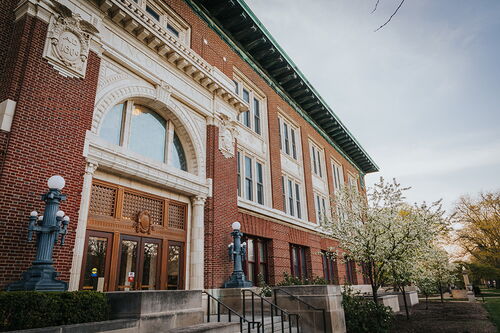Natural History Building recognized by U.S. Green Building Council

The Natural History Building has earned prominent distinction for energy efficiency and environmentally friendly construction practices in the wake of a recent $79 million renovation.
The historic building received Leadership in Energy and Environmental Design (LEED ®) Gold certification from the U.S. Green Building Council, the most widely used green building rating program in the world. Built in 1892, the Natural History Building reopened in 2017 after a three-year renovation to modernize and add classrooms, laboratories, and study spaces and enhance teaching, research, and collaboration environments.
LEED certifications are awarded based on a point system to earn one of four categories: certified, silver, gold, or platinum. From the beginning of the project, campus officials directed a significant amount of planning and design efforts toward a goal of attaining gold certification, thereby creating healthier and more sustainable spaces to benefit students, faculty, and staff.
The Natural History Building renovation received high merits for being conducted in an environmentally efficient manner, with close attention paid to preventing pollution. More than 76 percent of the construction waste was recycled. A large amount of the material removed from the building was reused.
Rapidly renewable materials, such as bamboo flooring, were used in the renovation project. The Natural History Building also received points for water efficient landscaping, energy efficient heating and air conditioning, high levels of daylight for natural lighting, occupancy sensors, and continual energy monitoring.
“Energy efficiency was one of our primary concerns in renovating the Natural History Building,” said Feng Sheng Hu, the Harry E. Preble Dean of the College of LAS. “We are pleased that the U.S. Green Building Council granted us gold certification. In every step of the process, we modernized and expanded the capabilities of this critical building in a sustainable manner.”
The renovation significantly improved water efficiency at the Natural History Building. The building was able to reduce its water usage by at least 20 percent, which is significant given the large number of laboratories and high student traffic in the building. The project also received high marks for using an existing site, having great access to public transportation, and incorporating bicycle parking.
Executive Director of Facilities & Services Mohamed Attalla said, “Having more than one million gross square feet of certified green buildings on campus is a tremendous achievement that exemplifies the university’s commitment to sustainability, personal wellness, and facilities excellence. These transformative and beneficial spaces are already impacting today’s building occupants and will continue to attract the best and brightest students, teachers, and researchers in the future.”
The Natural History Building houses the School of Earth, Society, and Environment, including the departments of Atmospheric Sciences, Geography and Geographic Information Science, and Geology. It also houses teaching programs for the School of Integrative Biology, which includes the departments of Animal Biology, Entomology, and Plant Biology, and the Integrative Biology Honors Program.
There are sixteen LEED certified buildings on the Urbana campus. The Natural History Building joins other prominent facilities such as Lincoln Hall, which received platinum LEED status after it was renovated in 2012. The university is a national leader in sustainable building design by establishing requirements of LEED certification for all major renovations and new construction projects with values greater than $5 million, applying these techniques to both new construction and historic preservation.








